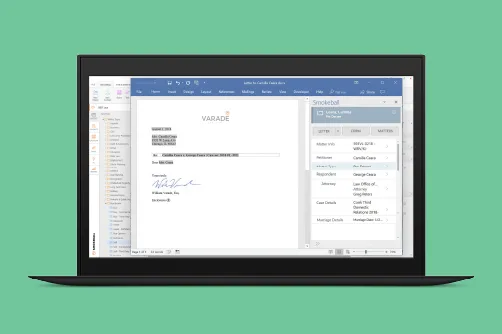How to Organize Your Estate Planning Law Firm with Document Automation
Written by
|
July 12, 2023
Written by Smokeball
|
July 12, 2023

Written by Jordan Turk
|
July 12, 2023

Use legal document automation to organize and speed estate planning
As an estate-planning attorney, it’s your job to ensure your client’s assets are protected and distributed according after they pass away. Each family comes to you with unique goals and aspirations for their estate plan, so every matter is tailored to your clients’ needs. You create detailed bespoke estate plans with care, so investing in tools like estate planning law firm document automation software can expedite your matter creation.
You’ve just spent two hours with your client going through their entire estate planning questionnaire during the intake process– identifying their family members (and their corresponding problems), accounts, properties, businesses, liabilities, insurance policies, wishes, fiduciaries, beneficiaries, and on and on. You darn near know more about them than they did before they booked their appointment. And now that you have all this information, where does it all get stored, and how does it make its way to their estate plan?
Download Now: Essential Guide to Law Firm Succession Planning
Analog or Automated Document Assembly?
Like most estate planning attorneys, you probably print out the intake questionnaire a new client sent you before the meeting. During your planning meeting, you take hard-to-read handwritten notes all over the multi-page document and then scan them to the file. Now, whenever you need to look for information on that client, you pull up the PDF and search page by page or rely on the hard copy.
Next, you probably do one of two things:
- You manually input this information into an expensive estate planning software with a series of questions designed to prepare a complete estate plan best suited to your clients.
- You pull up your own templates you’ve cultivated over the years and manually input the information using find/replace and copy/paste.
When you’re done, you add custom language as needed and then review again and again and again to ensure you didn’t misspell any names or mess up the pronouns/usage after entering the information a gazillion times.
Limits of Using Manual Templates
Historically, lawyers have done estate planning by pulling up a templated document, making changes, and hoping they accurately update everything. However, with the advent of document generation software, this outdated method is becoming a thing of the past.
There are limitations to using Microsoft Word’s copy, paste, and find and replace functions to manage edits. For example, your team needs to take great care to ensure that subject-verb agreement and pronoun usage remain consistent throughout the document. Relying too heavily on find and replace can lead to mistakes, which will reflect poorly on your professionalism.
Moreover, in a field that primarily charges clients on a fixed fee basis, doing things the old way is time-consuming and costly. The value the client receives from your guidance and the peace and mind of having a comprehensive estate plan is the same whether you spend 10 or 20 hours on the file.
Using Estate Planning Document Automation to Transform your Practice
When it comes to estate planning, the stakes are high for clients, and we’ve discussed how time-consuming the tasks can be for lawyers. That’s where automated document assembly comes in.
By utilizing this technology, your law firm can streamline the creation of important documents like wills, trusts, and powers of attorney. Not only does this improve efficiency and save time, but it also helps ensure accuracy and consistency for your clients. Document automation allows for customizable options to address each client’s unique needs.
The ability to quickly and accurately customize documents for your clients sets you apart from competing law firms. In an ever-evolving legal field, staying current with technology is crucial in providing top-notch service to your clients.
Want to see the before and after of document automation at a glance? Download our free infographic: Before & After Implementing Legal Document Automation
Realistic Expectations of Document Automation and Assembly
While mass document automation and document assembly software can undoubtedly streamline the drafting process, it does have limitations if it’s not part of a complete practice management solution.
Duplicated Data Entry
Often, most software requires a significant amount of data input for each individual document, which can be time-consuming and leave room for error. In addition, because the templates are generic, verbose, and voluminous, the end product may not always be formatted correctly. So after your data entry, you may still need to manipulate your documents after you’ve created them.
Cost and Platform Overload
Using a separate document automation tool tacks an additional expense to your technology stack. Instead, consider practice management software that includes document automation and assembly tool. Consolidating multiple technologies into one platform can save your firm money by offering a simplified pricing model.
Security Concerns
Security should be a top priority when evaluating document automation and assembly software for your law firm. When you work with multiple software, this leaves room for your law firm to be vulnerable. You have client data in numerous places, which exposes room for security breaches–especially while communicating with your team.
Instead, you should consider a platform that houses all client information and is easy to manage, making it simpler to keep your data safe and secure. A platform that allows teams working on sensitive matters to see updates to the case in real-time, assign tasks and workflows to each other, and communicate internally and externally. This approach allows for a more holistic approach to security which is essential for protecting client data.
For these reasons, it may be worth considering a complete practice management service that will partner with your firm to create personalized, proprietary templates for easy document automation.
To get a full overview of legal document automation, download our free eBook, Law Firm Document Automation: The Basics
Benefits of Using Case Management Software with Automation
When working within a case management system, all the information captured from your estate planning meeting can be entered into your case details fields once but pulled as many times as needed to prepare documents. When you partner with a service that can help you configure your proprietary estate planning templates, you can create a variety of fields that will automatically pull information upon opening the document. And as long as the information is entered the first time correctly, the automation cures any spelling or grammatical issues. It’s legal drafting magic.
Because the client details are organized neatly in your case management system, you can easily find pertinent information and any memos to file, making it much easier to customize the template to suit your client’s needs.
Finally, if your program has the capability to capture asset tracking details, you can quickly review this information for your clients as it pertains to things like beneficiary changes and trust funding. Asset tracking is an essential component of client management and financial planning.
By keeping up-to-date records of a client’s assets, you can ensure that their financial goals and needs are met. Adding asset-tracking details to your case management software will allow you to automate trust funding letters. Additionally, in the practice management software, you can add the contact information for all parties involved, so sending these documents is effortless. As a bonus, if your firm has a client care plan, this is a great way to maintain your clients’ financial and property records as you continue a lifelong relationship.
Watch the on demand webinar: How the Most Successful Estate Planning Law Firms Run Their Practice
Speed Up Your Estate Planning
To fill out forms faster and provide a better experience for your clients, you need an estate planning document automation solution to help you fill out forms more quickly, improve your client experience, and upskill your legal staff in one place. With Smokeball, we can help you speed up the process while maintaining accuracy because you can easily add asset tracking details, set up trusts, and handle complex matters with ease.
If you’re looking for ways to improve your practice and provide better service to your clients, read related content on our website. We have plenty of resources that will help you get started with document automation today.
Other Related Resources:
See How Doc Automation Can Make Your Firm Life a Breeze
Download NowLearn more about Smokeball document management for law firms:
Book Your Free Demo
Ready to see how Smokeball client intake software helps you Run Your Best Firm? Schedule your free demo!


















